VINE THE







16 INDUCTION COOKING: IS IT RIGHT FOR YOU?
Energy efficient, powerful, fast and easy to clean — an induction stove could be in your future.
By Catherine Walthers
19 GO NATIVE!
Find out how to landscape your home with a nature-based, native plant approach.
By Tim Boland and Sakiko Isomichi
Editor
Usually,
I’m the one who’s all about the pretty flowers (Daddy’s Dahlias, page 10), the delicious food (Quitsa Kitchen, page 8) the good books (In the Dirt, page 6), and the friendly dogs (Canine Greeters, page 26). And as you can see, in editing this issue, I’ve not neglected the things that can make life on the Vineyard brighter, tastier, and cozier. But the Cancer the crab in me has me retreating ever so slightly into my shell, subconsciously, I guess, looking for what may lurk around the corner. But it’s not a bad thing to be prepared!
As I’m finally getting to update my tiny kitchen, I’m wondering if I should be installing an induction stove, which would be more efficient, more environmentally friendly – and faster –than my gas range. The future is electric! On page 16, Catherine Walthers walks us through the benefits of induction and tells us why she loves it.
I'm also up for a garden refresh, since I lost a bunch of perennials over this very cold winter. So I’m grateful to Plant Local Martha’s Vineyard for a great new guide to using more native (drought-resistant, wildlife friendly) plants in my designs (page 19).
And yes, I admit, I’m pennypinching a bit. That’s why I’m all in on shopping at Island thrift stores (page 5). If you think about it, even the hard things – saving money, improving energy efficiency, adjusting for climate changes – can be fun if you take the right approach. Happy spring!
Susie Middleton Features
4 EDITOR’S NOTE
5 ON THE ROCK & BOOKS
8 VINE & DINE
Five Things to Eat at Quitsa Kitchen
10 Q&A
Fresh Cut Happiness:
An Interview with Jim Carnazza
24 THE VIEW
Canine Greeters:
Meet Pearl and Cait
26 BY THE NUMBERS
Flora & Fauna
EDITOR
Susie Middleton
ART DIRECTOR
Jared Maciel
CONTRIBUTORS
Sissy Biggers, Tim Boland, Chris Burrell, Molly Coogan, Mindy Dutka, Ray Ewing, Laura Holmes Haddad, Sakiko Isomichi, Tim Johnson, Cathy Walthers.
PUBLISHER
Monica Brady-Myerov
GENERAL MANAGER
Sarah Gifford
ADVERTISING DIRECTOR
Frederica Carpenter ads@vineyardgazette.com
AD SALES TEAM
Carrie Blair, Isabela Fernandez, Serena Ward
MARKETING & SPONSORSHIPS
Tresa Lovio-Slattery
MARKETING CONSULTANT
Kharma Finley-Wallace
AD PRODUCTION
Jane McTeigue, McKinley Sanders
Copyright 2025 by the Vineyard Gazette Media Group. No part of this publication may be reproduced without the written permission of the publisher.
To subscribe to the Vineyard Gazette, visit vineyardgazettestore.com Vineyard Gazette Media Group
P.O. Box 66, 34 So. Summer Street, Edgartown, MA 02539 thevine@vineyardgazette.com | 508-627-4311



Who doesn’t love a bargain — especially these days? If you’re looking to trim your budget — or just enjoy hunting for cheap treasures, the Vineyard’s got some great options. Pro tip: visit these spots often as inventory changes regularly.
1. The iconic Chicken Alley Thrift Shop expanded their retail space at the end of last year, and if you haven’t been in, you’ll definitely want to check it out. Now there’s more shelf (and rack) space for popular items like dishware, lamps, books, fabrics, clothes, shoes — and especially kitchenware. Need a lobster pot? Crockpot? Yogurt maker? Stir-fry pan? Coffee press? Casserole dish? The price is right on just about all of these items — and the proceeds from your purchases benefit Martha’s Vineyard Community Services. 38 Lagoon Pond Road, Vineyard Haven.
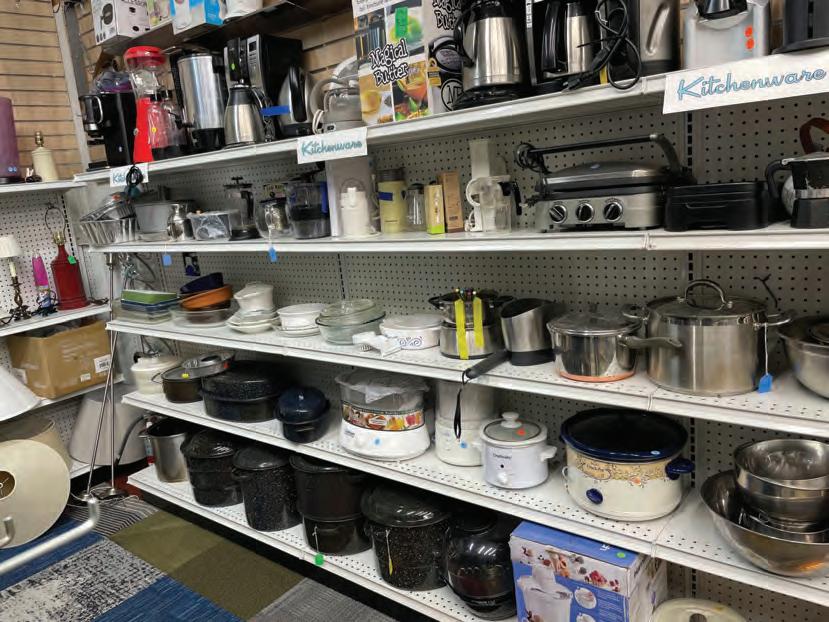
2. Also in Vineyard Haven, Act Two Second Hand Store is a great place to scope out furniture, housewares, vintage dishware and clothes. When we last visited, there was even a free box out front. But inside, we found a set of colorful votive candle holders for $1 each and a wide mason jar for flowers for $5 and called it a success! Act Two is a non-profit that benefits the arts on Martha’s Vineyard through direct grants to other non-profits. 66 Main Street, Vineyard Haven.
3. While you’re on Main Street, be sure to stop in Bunch of Grapes Bookstore to check out their adorable bargain section tucked in a little room off the back of the store. You never know what you’ll find there on any given day. It could be a copy of the beautiful coffee table book, Schooner, by Tom Dunlop and Alison Shaw. Or it could be something thrilling, like a David Baldacci novel. You might even find a box of notecards, too. 23 Main Street, Vineyard Haven.
4. Last year, John Robert Hill’s Second Treasures MV moved from its Beach Road location in Vineyard Haven to Uncas Avenue (across from The Barn, Bowl & Bistro) in Oak Bluffs. You can’t miss the store, as there’s always an interesting and eclectic line-up of furniture and large-scale vintage items right out front. Inside, everything from 1940’s Steiff stuffed animals to McCoy pottery to large works of art awaits you. 8 Uncas Avenue, Oak Bluffs.
1 2 4 3 5
5. What if you’re in the market for antiques, art and classic vintage pieces?

Visit long-time Edgartown Main Street fixture Past and Presents (42 Main Street). Or check out Creekville Antiques, formerly in Menemsha, when it opens in its new location in Vineyard Haven this summer. (Faience pottery, pictured at right, was a find in their old location.) It will be located in the storefront next to the Mansion House Inn (9 Main Street). Another destination for great finds — especially painted vintage furniture — is Able to Cane Aniques in West Tisbury (96 State Road.)



BY MOLLY COOGAN
This year more than ever, we crave the kind of solace spring brings with the trees budding and tender shoots emerging from the soil. In gardening books we can imagine our hands in the dirt, even if it’s still a bit too chilly to really dig in. A few books on my list, which I think transcend the green thumb/brown thumb divide, offer pragmatic and visionary ideas about what a garden can be.
The Kindest Garden: A Practical Guide to Regenerative Gardening by leading British landscape architect and horticulturalist Marian Boswell (Frances Lincoln, $30) focuses on improving and replenishing biodiversity through our gardens, creating beautiful sanctuaries while making an active contribution to the health of the planet.
Meanwhile in Kent, on a windswept pebble beach (or a “shingle beach”
as it’s called across the pond), in the shadow of a nuclear power plant, the magic of late artist, filmmaker and AIDS activist Derek Jarman’s garden is captured in a handsome 30th anniversary edition of the simply titled Derek Jarman’s Garden (Timber Press, $30). With an introduction by Jamaica Kincaid and photos by Howard Sooley, the reader is transported to the sandy, salty grounds of Prospect Cottage, which Jarman transformed into a paradise of plants, art and all manner


of flotsam. The book offers practical advice on creating an oasis of salttolerant plants and provides plenty of inspiration for what to do with all the driftwood, lobster buoys and rusty whatevers you’ve been saving from your beach walks.
And while gardening can certainly be a solitary, meditative practice, it’s also a wonderful way to engage and connect with children. Little Green Fingers: Easy Peasy Gardening Activities (Little Gestalten, $24.95) by
Claire Philip is packed full of inspiring, creative and simple activities: growing fruits and vegetables, creating fun art projects with nature, learning about the natural world and how plants grow and learning to observe the green spaces around us.
Here’s wishing you a bountiful season with minimal pests.
Molly Coogan is co-owner of Bunch of Grapes Bookstore in Vineyard Haven.







BY LAURA HOLMES HADDAD • PHOTOS BY RAY EWING
Walking into Quitsa Kitchen is like entering a friend’s living room. In fact, chef/owner Theresa Manning had her friend Scott Mullin of Studio Scott Mullin in Vineyard Haven design the interior space (the former Life at Humphreys bakery) to be a comfortable and welcoming place to linger.
Drawing from her many years as a caterer, Theresa offers an array of made-from-scratch breakfast, lunch and dinner items. Theresa wanted the menu to be unique but accessible, and it is just that: classic comfort food with a modern twist. In the morning, the pastry case is filled with fluffy scones, light-as-air muffins and an array of cookies from baker Amy Miller, and you can also sit down for a made-toorder breakfast or lunch. All day long, you can nab salads and sandwiches from the “grab and go” fridge. Better still, you can also pick up dinner: entrées like lasagna and chicken curry
with rice are also available to go. And Theresa is committed to having something for everyone: the fridge always has meat, vegetarian, glutenfree, and Alpha-gal friendly options. (Check the Quitsa Kitchen Instagram page for daily specials.)
Stop in for breakfast on the way to an early boat, grab a picnic on the way to the beach or get a delicious weeknight dinner for the family. And linger if you want to: meet a friend and settle into a cozy chair or window seat, have a meeting or sit at the communal table. There are ample outlets for charging devices and free Wi-Fi. Between the friendly vibe and the fresh, flavorful food, Quitsa Kitchen is poised to be a go-to for locals and visitors all year long.
Laura Holmes Hadded is a former cookbook editor, frequent contributor to The Vine, and creator of the Substack newsletter, lovely & delightful.

455 State Road, Vineyard Haven 508-338-7787
Open seven days: Grab-and-go, 6:30 a.m. to 6 p.m.; breakfast served 7 a.m. to 11 a.m.; lunch served 11 a.m. to 2 p.m. Online ordering available quitsacuisine.com @quitsakitchen_mv
Quitsa Kitchen baker Amy Miller is baking up some of the fluffiest biscuits on the Island, and they only get better when transformed into a breakfast sandwich. The “Stack” comes with two eggs and cheese (add bacon, ham, sausage, onion, spinach, or tomato if you like) and will hold you until dinner. This is one of the best breakfast deals around — just be sure to grab extra napkins.
This has become my official Sunday morning breakfast, offering the perfect play on spicy, sweet, and savory flavors. A crispy yet tender blue corn waffle (glutenfree) comes with a savory house-made sausage patty, two eggs, and a side of spicy hot maple syrup.
This sandwich proves that just a few perfect ingredients can create one unforgettable flavor. A piece of lightly fried burrata is layered on focaccia and topped with fresh arugula. The house-made tomato jam spread on top brings it to the next level. You can pick up a jar of that to go from the refrigerated case.
If you love Asian dumplings and breakfast sandwiches, get ready for this umami breakfast bomb: a soft, scallion-flecked bun slathered with sweet chili sauce encloses a pork dumpling-style patty topped with a soy and ginger glaze and a fried egg.

As a California native, I’m generally skeptical of Mexican food on the East Coast. But Quitsa Kitchen’s version of this classic Mexican dish is satisfying on every level. Generous amounts of juicy shredded chicken are rolled in corn tortillas and covered with a mild red enchilada sauce and topped with shredded cheese. Grab it from the to-go fridge when you see it; add a salad and you’ve got a fabulous weeknight meal in 20 minutes. One container feeds three to four adults.
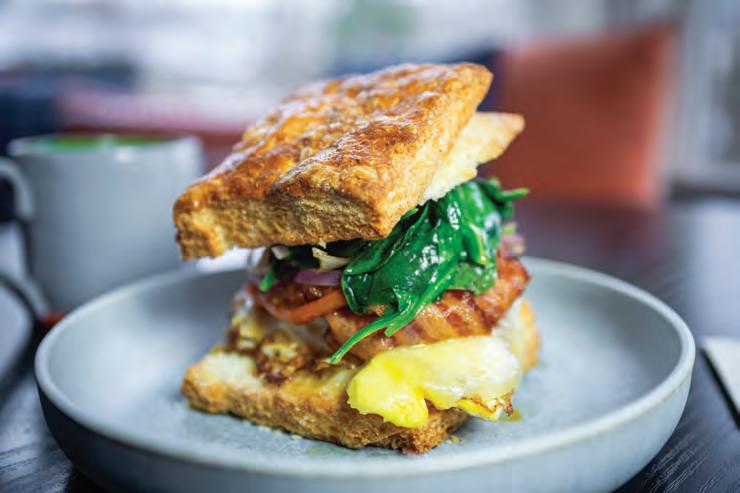
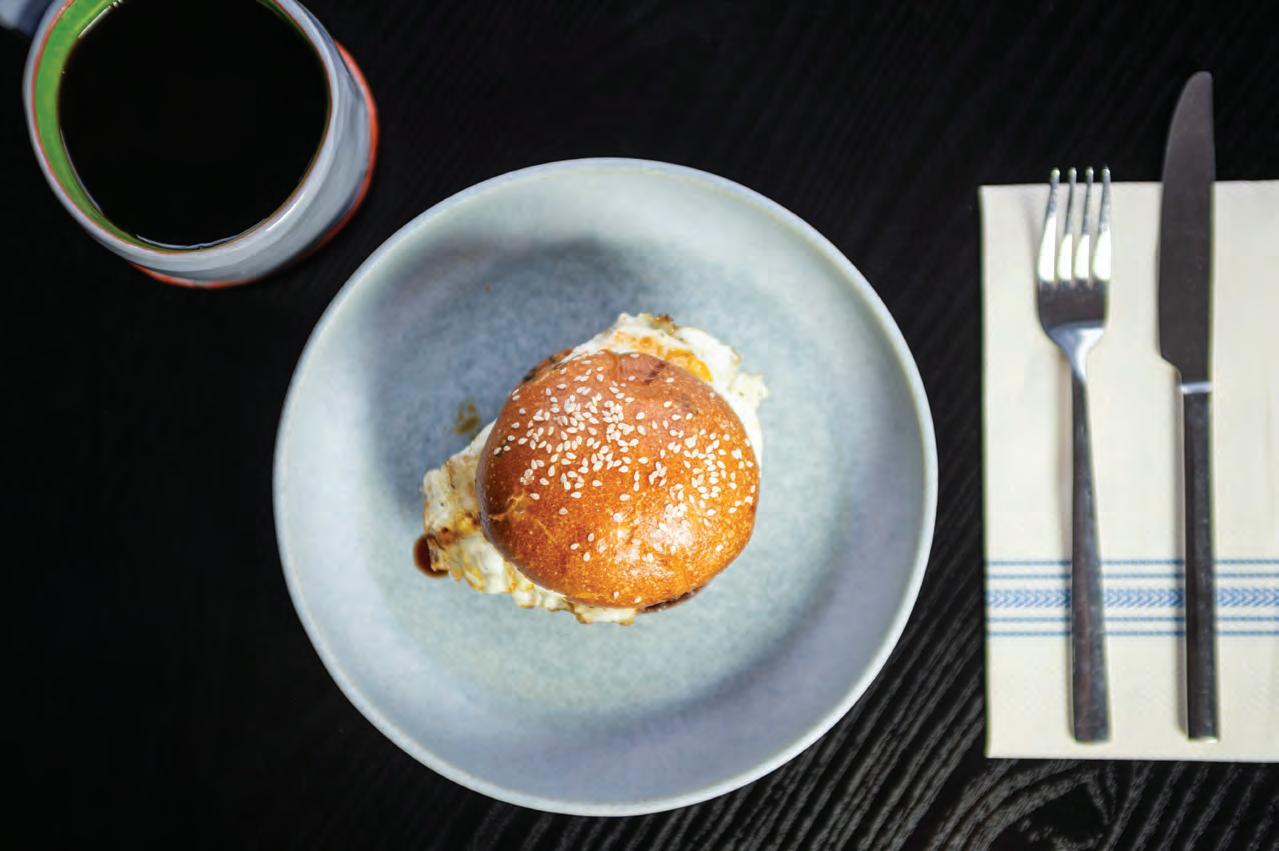
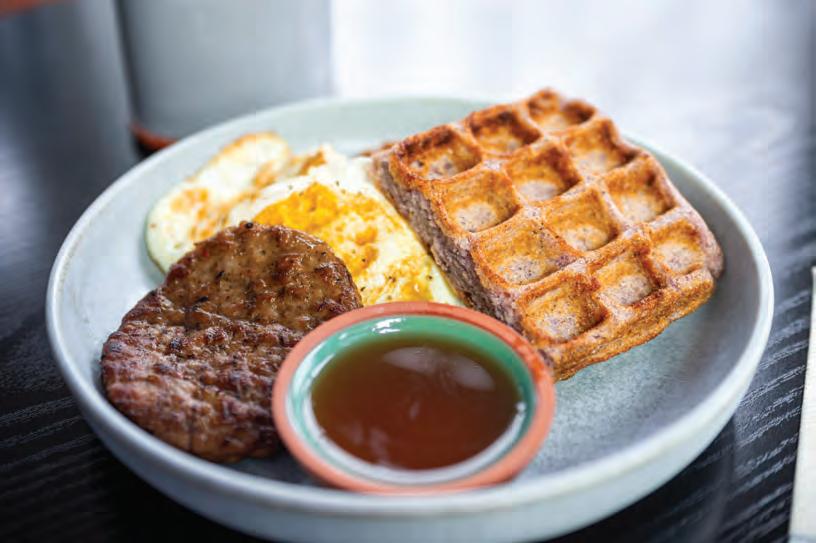


BY SISSY BIGGERS
On Martha’s Vineyard, few flowers capture the Island’s late-summer beauty quite like dahlias. Renowned etiquette expert and summer resident Emily Post was known for her vibrant dahlia blooms as large as pie plates on Fuller Street — an Edgartown curb appeal still in place a century later. In the height of summer, on the way home from South Beach, I have often taken a detour-worthy route to pick from the colorful buckets at Daddy’s roadside stand on Clevelandtown Road, now an Island summertime fixture. But it wasn’t until I wandered into a blues night at The Pawnee House in Oak Bluffs last October that I finally put a face to ‘Daddy.’ There, behind the soulful harmonica, Jim Carnazza was pouring his heart into the blues — just as he does into his dahlias, which he was generously giving away to patrons that night.
With a scientist’s curiosity and a musician’s soul, Jim has turned his love of dahlias into both an art and a science. What began as a passion project has blossomed into a thriving “cottage” industry, with his stunning blooms gracing farmers’ markets, hotel lobbies, and restaurants. If you catch him and his group, BlueSwitch, performing during dahlia season, you might just leave with a bouquet of his flowers and a favorite new blues band!
I sat down with Jim to talk about his journey to the Vineyard, what drew him to dahlias, and the art (and science) of growing these stunning flowers.
Q. What first brought you to the Vineyard?
A. Well it’s funny, we summered in East Falmouth when I was a kid and I
remember sitting on the beach at night watching those ferries go across and wondering what it was all about! Fast forward to my college years and I was working summers tagging lobsters for John Hughes at the Hatchery and for Manny Correllus at the State Forest. [Named Manuel F. Correllus State Forest in his honor in 1955.] Manny was the funniest guy who loved to tell stories, especially about John F. Kennedy and his dealings with the Department of the Interior.
Q. Those are classic Vineyard experiences which I imagine made you want to stay.
A. It was the simple beauty of the Island. And, of course, the fishing. You know, the Vineyard in the late ‘70s was a very, very cool place — and it still is.
In Edgartown, the Colonial Inn and Lou’s Worry, where Rockfish is today, were the hubs. The Colonial Inn even had a Japanese garden with little bridges over the water — the perfect spot to try and steal a kiss! Now as a musician I just love the Island music scene and the music community.
Q. When did you and your wife, Cory, decide to make the Island your home?
A. We were living in Holden, Mass., and I ran a molecular lab for 35 years — a company I started based on sequencing genetics. My wife’s family is from the Vineyard. She has an old Vineyard name, Vose. We were actually staying at her grandparents’ house in Wellesley while they were here for the summer. They had the Vineyard Gazette delivered, and one day we opened it up and saw a $5,000 house that needed to be moved. That’s how we got our foothold here and our first house. But I’m also related to the Vineyard. My ancestor, Benjamin Hoar, was a whaling captain and carpenter on Chappaquiddick in the late 1600’s.
Q. When did you establish Clevelandtown Road and dip your toe into the soil for growing dahlias?
A. We got a really good deal on a house on Clevelandtown Road with an extra building lot, which turned out to be a farm. I’d tried growing roses in Holden for years because I love flowers, but it

Tried again here, but it didn’t go well. Then my wife said, “Hey, have you ever heard of dahlias?” And I was like, “No!” And she said, “Try dahlias!”
Q. What made the dahlias take?
A. The soil on our property. When they came to rip out all the bittersweet and other stuff, the guy running the machine said, “This is really unusual — you’ve got about four feet of topsoil.” He digs for a living and had never seen such beautiful topsoil. We looked it up in the annals at the Martha’s Vineyard Museum, and it turns out the property was a dairy farm for 35 years with 16 milkers. Those cows were raised right there. I was like, “Wow, this is great!” And the way the sun hits the field is perfect. If you stand in my field, it’s 15 degrees warmer than other places around. So that first year, I planted 400 dahlias just laying them out in rows, and now I’m up to 1,500 to 1,800 on a 100’ x 80’ space.
Q. So you have this lucky break, you’ve got the sun and this incredible soil, but there still must have been a lot to learn.
A. Yes. There was the whole cycle to learn. When the tubers come out of the ground, they get divided, washed, cleaned, and stored in sand and

give it a little water and fertilizer. Don’t use Miracle Gro® – the nitrogen is too strong. You want the nitrogen to be the lowest percentage of the three numbers you see on the package, something like 5-10-10. I get rose fertilizer at Granite and use my hose feeder.
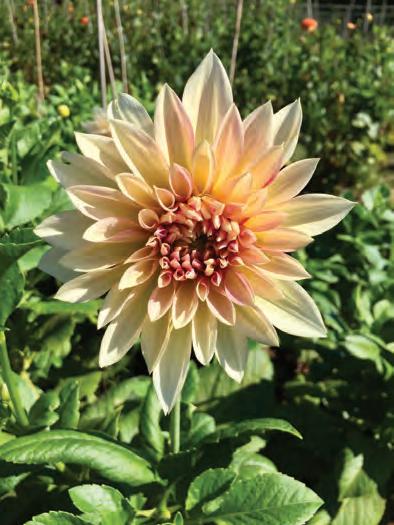
vermiculite. I do 75 percent sand, 25 percent vermiculite, mixed up in a wheelbarrow. Then I throw them into a plastic bag, seal it completely, and store them in cardboard beer boxes in my basement. The cellar temperature stays between 40 and 55 degrees. If it drops below 32 degrees, they can freeze. The dahlia itself acts just like a potato. It has an eye that throws up an apical meristem, which will grow into a plant. If they get too moist, they rot; if they get too dry, they shrivel.
Q. Do you start some of the plants over the winter? Do you have a greenhouse?
A. Yes, I start with about three dahlias in a pot — around 400 total for my first batch, say, 1,200 dahlias. I also use my greenhouse, and I section off part of my basement with plastic sheeting. I have a heater and multiple fluorescent grow lights on a timer, and the same for temperature, water, and fertilization. It’s a lot of work, but my goal is to get blooms by June 15 to keep things moving and make some money. I start the pots in February, hoping they don’t get too leggy. When I transplant them, it’s like landing a plane — you have to hit that runway just right for the best success.
Q. How was last year’s crop and how does that result influence
A. Last year was a bad year — everything was late, and I made much less money. I can’t really tell you why; it seemed like it rained fine, but everyone was saying the same thing — things were slow to come. But I was also picking flowers until late November. This year I plan on getting my greenhouse plants in between May 1 and May 15.
For the home gardener, I think the goal should be to have blooms to cut by the end of July, so plant the tubers when you plant your tomatoes. Wait for those beautiful late spring days when everything’s blooming, it’s green, and you can smell the mulch and dirt. Get yourself a thermometer. We want the soil to be about 60 degrees, and then put a bamboo stake right at the head of the tuber so you know where you planted it. The first shoots should come up in about three weeks – but some varieties won’t send up a shoot for three to five weeks.
Q. Is it now set-and-forget the tubers in the beds – watching our bamboo stakes for the first signs of shoots?
A. I suggest for the first three weeks you do not water them – which is a hard thing for most people, but if the tuber gets soggy it rots and you get nothing. As soon as you start seeing green come up,
Q. I read that dahlias have a fascinating genetic profile with eight sets of chromosomes, which allows for a huge variety of colors and some genetic drift. As a scientist in genetics, does that influence your approach to growing dahlias?
A. It’s a legitimate question, but I don’t pay much attention to it. With eight chromosomes, yeah, they can revert back to their original color if they were cloned or had another mother stalk. I had this beautiful Prince of Orange — a big medallion, bright orange, just lovely! But many I planted last year reverted to a five-petal, daisy-like bloom. Dahlias can surprise you. I’ve been happy that most of my breadand-butter dahlias, like the off-white Café au Lait (the bride’s favorite) and the Burgundy wine-colored Crème de Cassis, are coming in as I hope.
Q. How many of those happy stems do you cut and deliver to your roadside stand and to your clients?
A. When I deliver to The Charlotte Inn or to the Hob Knob, each bucket has about 25 to 35 stems: the big, yellow Kelvin Floodlight, the smaller, dark purple Arabian Night, and the bi-colored Melody Dora, which is my champion with its four-inch bloom. I put 160 of those in, and I’m usually cutting about 150 stems per week on that variety, 100 on others. The deep, rich Babylon Red — new last year — was a winner. I really recommend Babylon Red for beginners.
Q. I love your website tagline, “Fresh Cut Happiness.” Your customers must light up when they see you coming!
A. Honestly, people are just blown away. They start laughing when I arrive. I tell them, “I didn’t make that flower that beautiful.” I do everything I can and I’m not super religious, but I tell them, “It’s God who does this.”
Sissy Biggers is the Q&A columnist for The Vine and a contributor to Martha’s Vineyard Magazine.


JUNE 19, 2025 - 5 TO 6 PM
JUNETEENTH: legacy and promise Martha’s Vineyard Museum
Celebrate Juneteenth with a thought-provoking panel conversation hosted by the Vineyard Gazette and the Martha’s Vineyard Museum. This year’s topic: What is the history and future of the Juneteenth holiday?
JUNE 22, 2025 - 12 TO 2 PM
GOSPEL BRUNCH Edgartown Yacht Club
Join us for the annual Juneteenth Gospel Brunch with a live Gospel band. This is a ticketed event. All are welcome.
Stay tuned for more details, ticket sales, and panelist announcements.









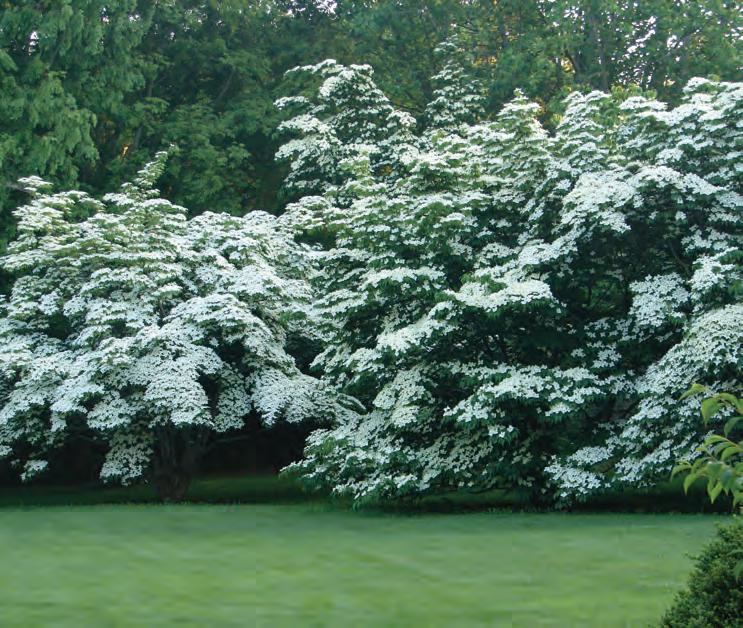
Grounds open sunrise to sunset year-round. Visitor Center & Plant Sales open seasonally. 795 State Road, West Tisbury | pollyhillarboretum.org | 508-693-9426





TUESDAY+FRIDAY
TOP NEWS STORIES, in-depth features, trends, profiles, commentary and stunning photography from the Vineyard Gazette, bringing you up to date twice a week.
THURSDAY Best bets for THINGS TO DO on the Island in the coming week, from special events, concerts and films to art openings, trail walks, kids’ activities and more.



Energy-efficient, powerful, fast, and easy to clean – an induction stove could be in your future.
BY CATHERINE WALTHERS
Early in my professional cooking career, I was happy to switch from the electric stove of my youth to a fullpowered gas stove. And now, some 30 years in, I’ve been introduced to induction cooking and I’ve made another switch. It’s making me even happier. I’ll explain why.
Sleek and smooth ceramic-glass induction cooktops look almost indistinguishable from flat-topped electric stoves, but aside from using electricity, that’s where similarities end. Induction stoves are more powerful, more energy-efficient and safer.
Induction cooking technology uses
electromagnetism to transfer energy directly from a copper element beneath the glass straight to the cookware — one simple advance that makes them more efficient and significantly more powerful than gas or electric stoves. Bypassing the heating of the cooktop surface makes induction stoves about 84 percent efficient, compared to approximately 74 percent efficiency for electric cooktops and about 40 percent for gas-powered stoves. (In other words, when cooking with gas, about 60 percent of the energy consumed is wasted.) When used, a gas stove heats the air around the pots and an electric stove heats the burner first, which in turn then heats the pot.
For cooks, induction technology translates into faster cooking times. Nearly everyone who has made the switch to induction, including myself, mentions how quickly water comes to a boil and how quickly food starts cooking. Consumer Reports® has found induction cooktops can boil water 20 to 40 percent faster than tested gas and traditional electric cooktops.
One downside of this technology is that not all pots and pans work with induction, and you may need to purchase a few new pans, depending on your current batterie de cuisine. With
an electromagnetic field inducing an electrical current directly to the cooking vessel, only pots to which a magnet sticks will work. Many newly manufactured pots (including ceramic and nonstick) are induction-ready, as well as all cast iron pans or enameled cast iron cookware like Le Creuset or Staub. Steel carbon pans are generally induction friendly, as is most, but not all stainless steel (depending on the nickel content). Aluminum is not ferromagnetic; much of the older All-Clad cookware (like I have) is not suitable for induction. Nor are those restaurant-style aluminum frying pans! But again, the best way to find out is to stick a magnet to the bottom of your pan.

Many people find their next favorite thing about induction is the easy cleanup. Julia Wells of West Tisbury, who has had her Bosch induction stove for five years and loves it, said she just uses warm soapy water and a soft cloth — nothing abrasive. Cleanup is easy! No more removing grates or cleaning around all the elements. If you like, you can also purchase cleaning products specifically designed to maintain the shine without any streaks on induction cooktops. But they aren’t necessary.
However, the feature that I personally find most helpful is that you can adjust the cooking heat instantly and precisely. My cooktop features numbers 1 through 10, with 10 being high and 1 low. If I’ve got a burner on high and water boiling, and I want to reduce to a simmer, the bubbling decreases instantly when I turn to a lower number. We all know how long that takes on an electric stove, and even a gas stove isn’t that fast. While I used to think I was getting an “instant” response with gas, I didn’t realize how much time I wasted adjusting the flame to get the exact temperature I wanted.

To get the lowest setting on my gas stove, for example, I’d often experience the flame going out altogether. I’d have to turn the burner on again and again. With induction, if I want a simmer, I turn to 1 or 2, and it is instantly where I want it to be. And it stays at that temperature until I make another adjustment! Julia mentioned how much she loves this feature, too. “The controls are so precise that you can put a burner on super-low, which is just brilliant. I can keep a pan of milk warm for my tea without it boiling over.”
Cooking on induction does have a learning curve and takes some adjustment. My first experience using induction came five years ago when I was cooking dinner at a new job for my clients and their guests. The first day was beyond frustrating. At one point, all six burners turned off simultaneously, and each one had to be turned on and adjusted again. But I soon came to appreciate the benefits, and continued my six-day-a-week cooking job the same as I would with a gas stove.
Marilyn Miller of Oak Bluffs said she thought her adjustment to using their new induction stove, a 30-
inch GE Profile, was about the same adjustment period as with any new appliance. “You learn with your stove; that’s what I did with the gas stove.”
Now using induction is second nature. And she loves cleaning the flat surface. “Honestly for me, it’s an amazing feature — not having to clean those heavy grates on top.”
Marilyn serves on the Oak Bluffs Climate and Energy Advisory Committee. She said it was the environmental plusses that led her and her husband Ron to get an induction stove in the first place. “We wanted to make the full switch from fossil fuels to electric.” They had installed solar, switched to mini-splits, and all that was left was changing their propane-fueled stove and clothes dryer to electric. That final push for them came soon after reports began emerging about a variety of pollutants emitted by gas stoves.
Gas stoves were first introduced in the early twentieth century and heavily advertised during the 1960s as the cool and sophisticated way of cooking. Looking back, there were early reports
of pollutants, but beginning in 2021 and over the next two years, reports flooded the media about the whole range of indoor pollutants emitted. It came as a surprise to many. “We knew
Consumer Reports® has found induction cooktops can boil water 20 to 40 percent faster than tested gas and traditional electric cooktops.
there were the bigger environmental issues about the use of propane,” said Marilyn. “But we didn’t realize the effect on the environment right inside our own house.”
Some of those pollutants include methane, hexane, formaldehyde, benzene, and nitrogen dioxide. One study, released by Stanford University, revealed that this mix of pollutants, especially the nitrogen dioxide, could be responsible for as many as 200,000 current asthma cases in U.S. homes.
To offer more information about the environmental hazards of gas stoves, as well as general articles on induction cooking versus other stoves, Marilyn has put together an online list called
Resources for Induction Cooking. It is located on the Oak Bluffs town website (oakbluffsma.gov) under the Climate and Energy Advisory Committee (full web address at right), along with information about other home energy topics such as going solar, using heat pumps, and buying electric cars.
Another safety feature of induction stoves is that burners cool down almost immediately when a pan is taken off so there is less chance of accidental burns. Models with digital controls often feature a child safety lock, too. Some have an “automatic” shut-off feature that will kick in if a pan is taken off. And some also allow you to set a timer to have your burner shut off after a certain amount of time. This might be handy when cooking rice.
DOING YOUR RESEARCH – AND TAKING A TEST-SPIN
Once you make a decision to buy an induction stove or cooktop, the next step is researching the many
brands and models, similar to buying any major appliance or stove. Since induction cooking is newish, I highly recommend asking friends who have purchased an induction stove or cooktop if you can visit and see how it works. Different brands have different burner arrangements (see below); most have digital controls but some have knobs. Ask your friend what they like or don’t like about their model.
Each of the town libraries on the Island now lends lightweight, portable single induction burners made by Duxtop. You can find them on the library websites under “things that can be rented.” Check one out for a week or two and cook on it.
Consumer Reports® offers a guide to induction cooking and buying. The prices vary widely too, and on the lower end, they start at just over $1000, more than basic electric or gas stoves which can be purchased starting in the $600-$800 range.
Once you have purchased (phew!), enjoy your time in the kitchen cooking faster and more efficiently.
Catherine Walthers is a private chef, author of four cookbooks and a new cookbook coming this summer called The Sea Table, produced by the Martha’s Vineyard Fishermen’s Preservation Trust. She lives in West Tisbury.

Try out induction cooking by renting a portable induction burner (made by
from any of our Island libraries.
SOURCES
• Database of information on induction cooking: oakbluffsma.gov/ DocumentCenter/View/11877/InductionCooking-Resources
• Model comparisons: consumerreports.org, nytimes.com/ wirecutter
Take a close look at burner configuration and controls before you buy.
COOKTOPS: Examples of 30-inch cooktops include these two from Bosch (near right) and GE Profile (far right). You can see that the Bosch has the largest burner slightly towards the back and center, while in the GE, the largest burner is to the right. The two left burners on the GE can be used at the same time with a griddle or large oval pot. Note these are just samples; there are many different configurations on the market and brands are constantly updating, so you'll have to do your own research.


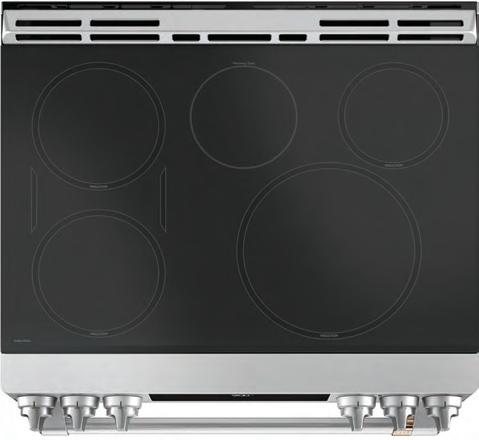

RANGES: While digital burner controls on induction stoves are often right on top of the glass surface (as above), some have the controls in a separate digital panel or in a traditional panel with knobs above the oven door. For people who are transitioning from traditional stoves especially gas stoves the knobs can feel (and look) more familiar than a digital panel. The trend in middleto high-priced ranges like the 30-inch GE Cafe (far left) and the 30-inch LG (near left) is towards knobs. Note the differences in these burner configurations, too!

Find out how to landscape your home with a nature-based, native plant approach.
BY TIM BOLAND AND SAKIKO ISOMICHI
What if you could form a partnership with your landscape — one that promotes wildlife, lessens your dependence on fertilizers and pesticides, and makes your yard more resilient in the face of climate change? Sounds pretty good, doesn’t it? Well, a collective of Island conservation groups, botanists, and landscaping practitioners has put their heads together to help you with this partnership. And the result is a nature-based landscaping guide called Plant Local, Martha’s Vineyard (Plant Local MV). The complete 48page guide is available as a free PDF download online at thevineyardway. org or by using the QR code on page 20. Additionally, there are limited print copies of the booklet, and the information is highlighted in posters
and brochures at Island nurseries, in both English and Portuguese.
The goal of Plant Local MV is to familiarize you with native plants and to help you be more comfortable choosing and planting them. After doing a series of intensive focus groups, the conservation collective — which includes BiodiversityWorks, Vineyard Conservation Society, the Polly Hill Arboretum, and several individuals, in partnership with the Martha’s Vineyard Commission — concluded that people didn’t know what native plants were or what they looked like. They received feedback that there wasn’t enough education or information available about native plants or lawn alternatives or how to implement them. Focus groups — especially landscapers and designers
— mentioned, too, the difficulty in meeting homeowner expectations of seaside landscapes and perfect lawns.
So, what are native plants? The guide includes a handy list, with descriptions and benefits, of the Top 20 native plants for the Island, from perennials such as cardinal flower and Joe Pye weed to grasses, trees, and shrubs such as Switchgrass, American holly, and beach plum. (Find the complete list on page 21).
The plants in the top 20 were chosen for their ecological benefits, growth characteristics, easy care, beauty, and availability at local nurseries. Additionally, Polly Hill Arboretum has an online database of all native plants, which numbers in the hundreds.
The guide illuminates the benefits of native plants. They tend to be more
resilient to weather extremes that include droughts, excessive rainfall, intense winds and severe storms –events we are seeing more often with climate change. Many native plants have deep root systems that require


less water and tolerate droughts. Their roots also help control erosion of soil and filter rainwater to help keep Island ponds clean. And native plants are essential to ensuring wildlife food and shelter — and to providing a network of habitats around the Island for wildlife.
Planting natives is increasingly important as the Vineyard’s population and development grow: A 2021 botanical study by Polly Hill Arboretum found that we have lost nearly 80 native plant species over the past several decades while non-native plants increased by over 200 species! And the folks who put together the Plant Local MV guide, working in tandem as part of a goal to implement the Martha’s Vineyard Climate Action Plan, have flagged native plants as an important tool in our Island-wide effort to build resilience in the face of climate change.
The guide includes tips for selecting native plants and getting started on a landscape design. It has a helpful section on caring for your native plants, including how much to water, mulch, and protect. It includes a spread on “problem” plants to avoid, including Japanese knotweed, bamboo, Autumn olive, English ivy, and wineberry which can be invasive. (In some cases “invasive” is more like intractable.)
And particularly helpful is a section called Plant This, Not That, which can guide your decision-making at the nursery or when working with a landscaper. For instance, a native groundcover called bearberry is a better choice than creeping myrtle (a.k.a. periwinkle or Vinca). While creeping myrtle can smother other
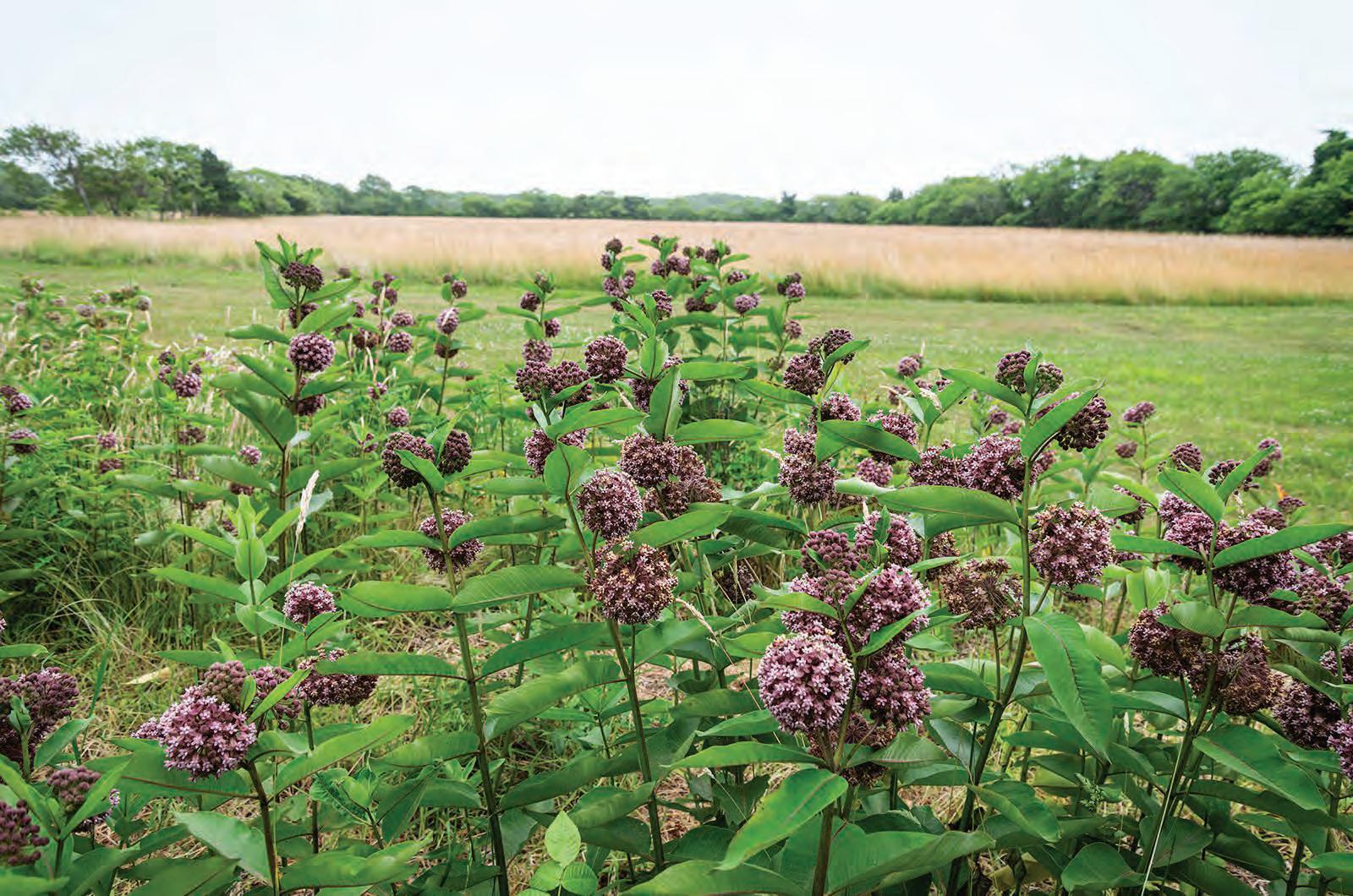
plants, bearberry provides food for birds and is a host plant for 14 species of butterfly and moth larvae.
Plant Local MV also lists common misconceptions about native plants. For instance: “Misconception #1: Native plants are messy. While some native plants can look more unkempt than others, you can have a stunning garden that also provides habitat for birds, butterflies, and other wildlife by using thoughtful design tenets, such as massing groups of plants in pleasing combinations.”
In the back of the guide are four useful garden designs created by Rich Couse and Sian Foulkes: the sun seeker, the shady stunner, the damp diva, and the waterless wonder. You can take one of these to a local nursery and create your new landscape.
Armed with all of this information — and the knowledge that you can improve wildlife habitats and plan for climate change in your own garden — you’ll be ready to join the Plant Local movement!
SOURCES
• Find the Plant Local MV guide at thevineyardway.org or use QR code.
• Find the Polly Hill Arboretum native plant database at https://www. pollyhillarboretum.org/wp-content/ uploads/2024/08/MV-Native-Plants-List. pdf
Tim Boland is a botanist, horticulturist, and executive director of the Polly Hill Arboretum. Sakiko Isomichi works with people, plants, creatures, and land.
While Plant Local MV is an initiative of The Vineyard Way (an Island-wide climate action plan) and a product of collaboration between BiodiversityWorks, Vineyard Conservation Society (VCS), the Polly Hill Arboretum, and the Martha’s Vineyard Commission (MVC), the nitty gritty work began when over 50 community members participated in seven focus groups. Focus group members included landscapers, plant nursery staff, landscape designers, Wampanoag Tribal members, gardeners, and homeowners.
The focus groups were assembled by Sakiko Isomichi, a 2023 Martha's Vineyard Vision Fellow, and three community liaisons — Cathy Verost, Deborah Silva Duarte, and Jannette Vanderhoop — with support from consultant Meghan Gombos and Liz Durkee at the MVC. Liz Durkee, who is retiring from her job as Climate Change Coordinator for the MVC this June, was noted by her team members for her steadfast support of the initiative.
Each focus group had five to 11 participants in it and met for three hours to discuss the challenges to native plants, lawn reduction,
and overall land use, ending with potential solutions to these challenges. Every conversation was spirited, full of ideas and suggestions, both aspirational and inspirational. Not only did the idea for the native plant guide come out of these discussions, but a number of big ideas to focus on – including making native plants more available at a scale appropriate to landscapers – emerged as well.
From there, Luanne Johnson (director of BiodiversityWorks) and Rich Couse (director of Natural Neighbors Program) collaborated with Samantha Look (executive director of VCS), Meghan Gombos, Zada Clarke (director of advocacy & community organizing, VCS) and Sian Foulkes (designer) to bring the guide to life, aided by grants from the Edey Foundation and from Mass. Municipal Vulnerability Preparedness program.
Scan the QR code to get your copy of the guide.

From hundreds of plants native to Martha’s Vineyard, the Plant Local MV team chose their top 20 based on the following criteria: availability at local nurseries, ecological benefits,
• Blue Flag iris
• Cardinal flower
• Joe Pye weed
• New England aster Orange butterfly weed
• Red columbine
• Seaside goldenrod
• Swamp milkweed
• Swamp rose-mallow
GRASSES
• Little bluestem
• Pennsylvania sedge
• Switchgrass


growth characteristics, easy care, and beauty. The guide gives descriptions and benefits for each of these plants. Find the full list of natives at pollyhillarboretum.org.
TREES
• American holly
• Beetlebung
• Eastern red cedar
SHRUBS
• Arrowwood
• Beach plum
• Bearberry
• Inkberry
• Sweet pepperbush








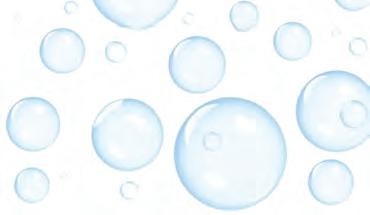





























































At Lambert’s Cove Inn & Resort, the welcome party includes two friendly border collies.
STORY AND PHOTOS BY MINDY DUTKA
Driving down Lambert’s Cove Road in West Tisbury, you might notice an unassuming sign that reads Lambert’s Cove Inn & Resort. But once you make the turn and journey down Manaquayak Road, you’ll find yourself enchanted. At the end lies a hidden gem, a pastoral eight-acre property that was once a working farm.
Today the Lambert’s Cove Inn & Resort, bought in 2022 by Stephanie and Jon Saunders of Cohasset, Mass., includes fine dining restaurant Woods and an English garden for wedding ceremonies, in addition to rooms and
cottages. And to the delight of many guests, the Inn welcomes both humans and their canine companions.
In fact, once you arrive, you might meet Pearl or Cait (or both), border collie rescues adopted by inn manager Bridget Sampson and her husband, chef Galen Sampson. The Sampsons are passionate dog lovers and hope that the presence of Pearl and Cait can help guests missing their pets to feel more at home. In turn, many guests report that the dogs are a highlight of their visits.
Even during the off-season, when
Bridget hosts a book club, everyone says one of the best parts of the gathering is hanging out with Pearl and Cait.
Bridget and Galen’s love of dogs extends to supporting community organizations. A notable collaboration was a fundraiser for Angels Helping Animals Worldwide, where the inn hosted a silent auction and reception that raised several thousand dollars in just a few hours.
What about visiting dogs? The inn offers two dog-friendly rooms, so plan in advance and reserve one if you
want to travel with your pet. If you are planning a wedding at the inn, your dog is welcome to participate in the ceremony. From rottweilers serving as ring bearers to dachshunds donning tiny tuxedos, weddings here celebrate the deep bond between couples and their pets.
And if you’re not able to travel with your pet, rest assured that Pearl and Cait can provide canine company in a pinch.
Mindy Dutka is a photographer, dog advocate, and founder of dogsimeet.com.


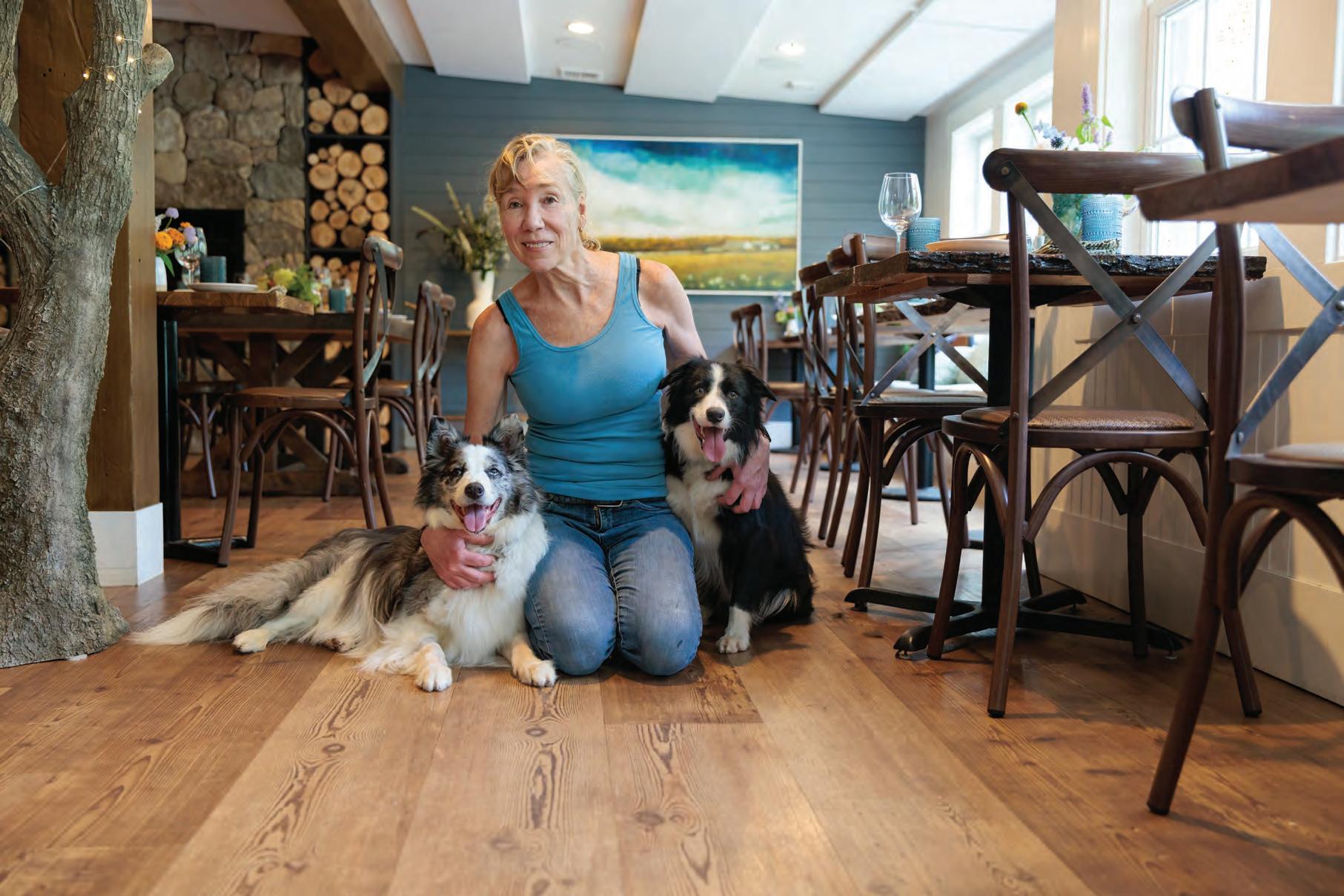
BY SUSIE MIDDLETON • ILLUSTRATIONS BY CHRIS BURRELL

FLY FAVORITES. A three-year-long study of nine species of plants that attract pollinators, conducted by BiodiversityWorks at eight Island farms, identified 300 different pollinators. Many of the pollinators were bees, but the count included 20 different taxonomic species of flies – and one plant highly favored by pollinators: goldenrod.
RIGHT ON! The population of the critically endangered North Atlantic right whale that frequents Vineyard waters has increased slightly, though scientists and conservationists still worry about the future of the species. A 2024 report from the North Atlantic Right Whale Consortium estimated that the right whale population rose to about 372 whales in the previous year, up from an estimate of about 358 whales in 2020.

THE TAKEOVER. A 2022 botanical study by Polly Hill Arboretum found that we have lost nearly 80 native plant species on the Island since 1998 while non-native plants increased by over 200 species. Turn to page 19 for more on native plants.


THE BUZZ. Based on data from studies over the last 20 years, there are an estimated 200 species of bees on the Island. While this group includes the highly social Western honey bee and the Eastern carpenter bee which build their nests above ground, nearly threequarters of the 200 species are soil-nesters. Also called ground-nesters, these bees – such as the hairy-banded miner bee and the pure green sweat bee – tend to be more solitary.
18
Number of endangered flora and fauna protected on the former Pimpneymouse Farm property on Chappaquiddick.
1,280
Number of species recorded and added to iNaturalist.com after two bio-blitzes (at Long Point Wildlife Refuge and Manuel F. Correllus State Forest) organized by The Martha’s Vineyard Atlas of Life last year.
7,000
Number of roseate terns — more than 50 percent of the U.S. population — that visit the Vineyard and neighboring islands while migrating to South and Central America.
to mark the the 50th anniversary of

Follow the Vineyard Gazette’s JAWS EVENTS PAGE for the most up-to-date information and articles.

JUNE 22, 2025



Our commemorative magazine featuring rare photos, firsthand accounts from Islanders, a detailed map of filming locations,and more.

SCAN TO ORDER
